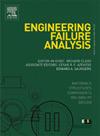Analysis of dynamic response and impact resistance of corrugated plate-reinforced concrete under simulated rockfall
IF 4.4
2区 工程技术
Q1 ENGINEERING, MECHANICAL
引用次数: 0
Abstract
In this study, corrugated plate material is used as the internal mold for the reinforced concrete structure, proposing a combined shelter structure designed to protect against rockfall hazards in mountainous areas. The research focuses on the impact of low-velocity rockfall (below 150 km/h) directly hitting both the reinforced concrete structure and the corrugated plate and reinforced concrete combined shelter structure. The accuracy of the numerical simulation results is validated through comparative analysis with indoor model experiments. Further investigation reveals the impact resistance and failure characteristics of RC (Reinforced Concrete) structures, CPRC(D) (Corrugated plate double-layer reinforced concrete composite structure) structures and CPRC(S)(Corrugated plate single-layer reinforced concrete composite structure), with the residual resistance index (RRI) introduced for the quantitative analysis of the residual load-bearing capacity of the protective structures post-impact. The results indicate that the shape of impact craters and the maximum impact force obtained through numerical simulations closely match the experimental findings, demonstrating the validity of the simulation parameters. Under the same impact energy, the maximum peak stress at various points in the CPRC structure is reduced by more than 50 % compared to the RC structure. Damage to the RC structure under rockfall impact is primarily characterized by central penetration failure and extensive development of diagonal cracks. In contrast, the CPRC structure effectively suppresses penetration, dent deformation, and crack propagation, significantly reducing the volume of concrete damage and the proportion of rebar damage, with the residual resistance index consistently remaining above 0.27.
The corrugated plate and reinforced concrete combined structure outperforms the reinforced concrete structure in several impact resistance factors, including maximum impact force, effective stress extremes, structural damage, and penetration depth. Additionally, after reinforcement with corrugated plates, the CPRC structure maintains a high level of impact resistance in most scenarios, even when the lower layer of rebar is eliminated, providing a theoretical basis and preliminary feasibility proof for the lightweight modification of the structure.
波纹板加固混凝土在模拟落石作用下的动态响应和抗冲击性能分析
在这项研究中,波纹板材料被用作钢筋混凝土结构的内模,提出了一种旨在防范山区落石危险的组合式防护结构。研究重点是低速落石(低于 150 km/h)直接冲击钢筋混凝土结构和波纹板与钢筋混凝土组合防护结构的影响。通过与室内模型实验的对比分析,验证了数值模拟结果的准确性。进一步研究揭示了 RC(钢筋混凝土)结构、CPRC(D)(波纹板双层钢筋混凝土复合结构)结构和 CPRC(S)(波纹板单层钢筋混凝土复合结构)结构的抗冲击性能和破坏特征,并引入了残余抗力指数(RRI)对防护结构在冲击后的残余承载力进行定量分析。结果表明,数值模拟得到的撞击坑形状和最大撞击力与实验结果非常吻合,证明了模拟参数的正确性。在相同的冲击能量下,CPRC 结构各点的最大峰值应力比 RC 结构降低了 50%以上。落石冲击对 RC 结构造成的破坏主要表现为中心贯穿破坏和对角线裂缝的广泛发展。相比之下,CPRC 结构有效地抑制了贯穿、凹痕变形和裂缝扩展,显著减少了混凝土的破坏量和钢筋的破坏比例,残余抗力指数始终保持在 0.27 以上。波纹板和钢筋混凝土组合结构在多个抗冲击因素方面优于钢筋混凝土结构,包括最大冲击力、有效应力极值、结构破坏和贯穿深度。此外,用波纹板加固后的 CPRC 结构在大多数情况下都能保持较高的抗冲击性能,即使在取消下层钢筋的情况下也是如此,这为结构的轻量化改造提供了理论依据和初步的可行性论证。
本文章由计算机程序翻译,如有差异,请以英文原文为准。
求助全文
约1分钟内获得全文
求助全文
来源期刊

Engineering Failure Analysis
工程技术-材料科学:表征与测试
CiteScore
7.70
自引率
20.00%
发文量
956
审稿时长
47 days
期刊介绍:
Engineering Failure Analysis publishes research papers describing the analysis of engineering failures and related studies.
Papers relating to the structure, properties and behaviour of engineering materials are encouraged, particularly those which also involve the detailed application of materials parameters to problems in engineering structures, components and design. In addition to the area of materials engineering, the interacting fields of mechanical, manufacturing, aeronautical, civil, chemical, corrosion and design engineering are considered relevant. Activity should be directed at analysing engineering failures and carrying out research to help reduce the incidences of failures and to extend the operating horizons of engineering materials.
Emphasis is placed on the mechanical properties of materials and their behaviour when influenced by structure, process and environment. Metallic, polymeric, ceramic and natural materials are all included and the application of these materials to real engineering situations should be emphasised. The use of a case-study based approach is also encouraged.
Engineering Failure Analysis provides essential reference material and critical feedback into the design process thereby contributing to the prevention of engineering failures in the future. All submissions will be subject to peer review from leading experts in the field.
 求助内容:
求助内容: 应助结果提醒方式:
应助结果提醒方式:


